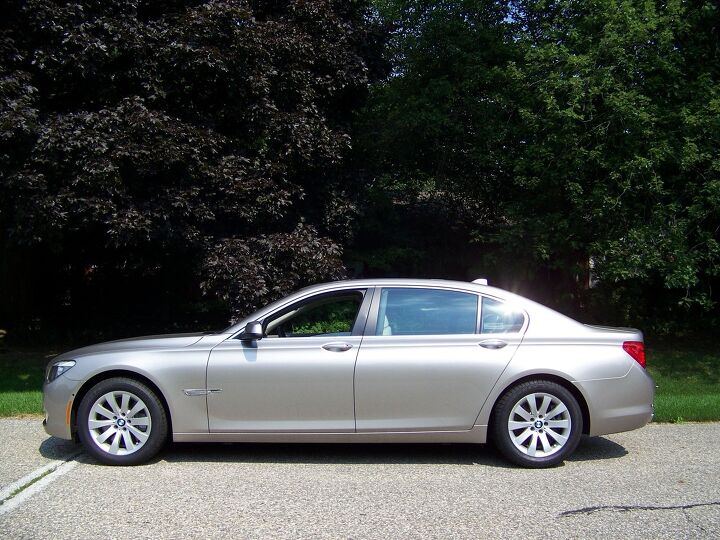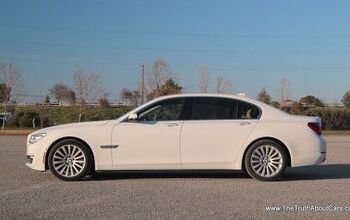Review: 2010 BMW 750Li XDrive
With its 2011 redesign the BMW 5-Series is now much more closely related to the 7-Series. It’s smoother, quieter, and–both for better and for worse–has the feel of a larger car. So, why would someone spend roughly $18,000 more for the 7? (Add another $3,900 for the extended wheelbase Li, and another $3,000 for AWD.) To find out, I took a 750Li xDrive for a spin after driving the new 550i.
Unlike the many manufacturers who slavishly copied its most distinctive details, most notably the humped up trunk with its droopy cutline, I was never a fan of the previous generation, E65 7-Series. The latest 7, the F01 (F02 in Li form, if you want to get picky about it), appears much slimmer and cleaner. It’s certainly a handsome car. There are no unusual, potentially off-putting details like the quad fog lights on a Mercedes E-Class or the RX-8-like fender bulges on the S-Class. If the exterior design errs, it is in being too soft, too conservative, and too much like an enlarged 3. Can a design be too timeless? This one could just as easily have been from the 1990s.
More of a problem for many people, if not for me personally: the main thing differentiating the new 7’s exterior styling from that of the new 5 is its length. Compared to the 2011 5-Series, the 750i has four additional inches of wheelbase and nearly seven additional inches of overall length. The 750Li adds another 5.5 inches, all of it in the rear passenger compartment. While Audi has similarly readopted the “same sausage, different lengths” philosophy with the new A8, no one will mistake a Mercedes E-Class for an S-Class.
Comparing interiors, F10 5-Series even more strongly resembles the F01 7-Series. The instrument panels are nearly identical, though the 7 benefits from some additional brightwork around the vents and the lack of a horizontal divider in the center stack. In both cars the nav screen, though enlarged, is much more cleanly integrated into the instrument panel. A wider, shorter center stack angled six degrees towards the driver visually connects the instrument panel with the center console rather than visually separating the two. In the 7, the shifter has returned to the center console, proof that the new car is much more driver-oriented. The car tested had the optional leather-upholstered instrument panel upper. This option costs $1,200 but adds at least four times this amount to the perceived price of the car. If you want a 7, you want this option.
Major gains have also been made in ergonomics and usability. There are more buttons, so the much-improved iDrive doesn’t have to be used for as many things, but these buttons are logically grouped and located. On the 7, the seat controls have been moved from the sides of the center armrest to a more conventional location on the sides of the seats. They’re no longer visible in the new location, yet are much easier to operate. Trial and error is no longer an inevitable part of the adjustment process. One idea worth stealing from the new Audi A8: displaying adjustments on the screen as they are made. One ergonomic slip: the door pull on the 7 is hidden and mounted too high up on the door. I knew it was there when I thought about it, but locating a door pull shouldn’t require any thought.
BMW’s multicontour seats, excellent for both long distance highway treks and the curviest hill country byways, are optional in the new six-cylinder 740i (not tested) but are standard in the 750. Unlike in the new 5-Series, these seats continue to include power-adjustable side bolsters. Because 7-Series owners are more likely to take corners aggressively? Typical of a large German sedan, the beltline is moderately high, and there’s clearly a lot of car around you, but not to the point that visibility is impeded or driver confidence is impaired. From the driver’s seat, the 7 feels much like the 5, just a touch larger. The tape measure backs up this impression: there’s less than an inch of additional front shoulder room in the larger car.
For an obviously different car, move to the rear seat. Even in the regular wheelbase 750i you’ll find three inches of additional shoulder room (artificially constricted in the 5?) and over two inches of additional legroom. Where the 5 provides adequate room and comfort for adults, the 7 does noticeably better on both counts. With the 750Li, rear legroom grows another 5.5 inches, for a total of 44.3. Unless people think “center forward” when they see you, your feet won’t be occupying the extra inches. The new 5’s trunk is actually a little larger than the 7’s, and a folding rear seat is only optional in the midsize car. So cargo capacity isn’t going to justify the jump.
The 550i and 750Li share BMW’s twin-turbocharged 4.4-liter V8, good for a virtually lag-free 400 horsepower and 450 pound-feet of torque. Even when tasked with motivating the 750Li xDrive’s quite considerable 4,861 pounds this powerplant provides the sort of effortless acceleration that used to require a V12. Though the V8’s soundtrack is suitability refined, others are either quieter or more inspiring.
While the F10 received a new eight-speed automatic capable of downshifting from top gear to second in a single bound, the F01 continues to employ the old six-speed. It’s not a bad transmission, but it’s not as smooth, as quick to shift, as flexible, or as efficient as ZF’s latest and greatest.
Another F10 innovation not present in the F01, at least not yet: electric power steering. The usual anti-EPS rhetoric aside, steering feel isn’t dissimilar in the two cars—when comparing the 750Li with its standard suspension to a 550i with the Sport Package. Comparing the 750Li to a 535i with the standard suspension, the larger car’s steering feels better weighted and more precise. Aided by optional active stabilizer bars, roll in turns is minimal. Despite its many extra inches and pounds, the 750Li is a car that can be intuitively placed right where you want it. It feels about a half-ton lighter than the scales suggest it ought to.
Although I live in Michigan, I’m wary of the dulling effect all-wheel-drive tends to have on a car’s feel. With BMW’s system this isn’t an issue. The 750Li xDrive feels so much like a rear-wheel-drive car in moderately aggressive driving that I had to recheck the “xDrive” badges on the front doors. Power is shunted to the front wheels only when the rears lose traction, and the rears don’t lose traction readily. Easily controllable throttle-induced oversteer remains a very real possibility.
The new 5 feels so smooth and quiet, I wondered what could be gained by stepping up to the 7. Quite a bit, it turns out. Within the first 50 feet it’s evident that the 7 possesses the sort of silky smoothness and insulated quietness that Lexus brought to the table. Your ears and the seat of your pants will attest that the larger car is a substantial step up from the 5. It sounds and feels like the $100,000 car it is.
And this, in the end, is what justifies the 7 even more than the additional rear seat room: compared to the 5, it simply looks, sounds, and feels more upscale and luxurious. With the F01, BMW has somehow managed to combine the silent smoothness of a Lexus with the handling for which its cars are known. Sure, the driving experience is more insulated than in a 5, but it’s not overly insulated for this class of car. It feels far better on a curvy road than any car pushing 5,000 pounds has a right to. Now is it worth the extra cost? For people seeking the highest level of luxury in a driver-oriented car, yes, it is. Perhaps the 7’s additional luxuriousness and rear seat room isn’t worth $18,000+ to you? Then spend “only” $67,000 or so on a perfomance-optioned 550i and perhaps feel like you’re getting a bargain.
Michael Kraesh owns and operates TrueDelta, an online source of vehicle reliability and pricing data
Michael Karesh lives in West Bloomfield, Michigan, with his wife and three children. In 2003 he received a Ph.D. from the University of Chicago. While in Chicago he worked at the National Opinion Research Center, a leader in the field of survey research. For his doctoral thesis, he spent a year-and-a-half inside an automaker studying how and how well it understood consumers when developing new products. While pursuing the degree he taught consumer behavior and product development at Oakland University. Since 1999, he has contributed auto reviews to Epinions, where he is currently one of two people in charge of the autos section. Since earning the degree he has continued to care for his children (school, gymnastics, tae-kwan-do...) and write reviews for Epinions and, more recently, The Truth About Cars while developing TrueDelta, a vehicle reliability and price comparison site.
More by Michael Karesh
Latest Car Reviews
Read moreLatest Product Reviews
Read moreRecent Comments
- MaintenanceCosts I wish more vehicles in our market would be at or under 70" wide. Narrowness makes everything easier in the city.
- El scotto They should be supping with a very, very long spoon.
- El scotto [list=1][*]Please make an EV that's not butt-ugly. Not Jaguar gorgeous but Buick handsome will do.[/*][*] For all the golf cart dudes: A Tesla S in Plaid mode will be the fastest ride you'll ever take.[/*][*]We have actual EV owners posting on here. Just calmly stated facts and real world experience. This always seems to bring out those who would argue math.[/*][/list=1]For some people an EV will never do, too far out in the country, taking trips where an EV will need recharged, etc. If you own a home and can charge overnight an EV makes perfect sense. You're refueling while you're sleeping.My condo association is allowing owners to install chargers. You have to pay all of the owners of the parking spaces the new electric service will cross. Suggested fee is 100$ and the one getting a charger pays all the legal and filing fees. I held out for a bottle of 30 year old single malt.Perhaps high end apartments will feature reserved parking spaces with chargers in the future. Until then non home owners are relying on public charge and one of my neighbors is in IT and he charges at work. It's call a perk.I don't see company owned delivery vehicles that are EV's. The USPS and the smiley boxes should be the 1st to do this. Nor are any of our mega car dealerships doing this and but of course advertising this fact.I think a great many of the EV haters haven't came to the self-actualization that no one really cares what you drive. I can respect and appreciate what you drive but if I was pushed to answer, no I really don't care what you drive. Before everyone goes into umbrage over my last sentence, I still like cars. Especially yours.I have heated tiles in my bathroom and my kitchen. The two places you're most likely to be barefoot. An EV may fall into to the one less thing to mess with for many people.Macallan for those who were wondering.
- EBFlex The way things look in the next 5-10 years no. There are no breakthroughs in battery technology coming, the charging infrastructure is essentially nonexistent, and the price of entry is still way too high.As soon as an EV can meet the bar set by ICE in range, refueling times, and price it will take off.
- Jalop1991 Way to bury the lead. "Toyota to offer two EVs in the states"!






































Comments
Join the conversation
Yawn... do people still buy these?
Too bad GM killed the Corvair. BMW clearly needs a new one to copy styling from.